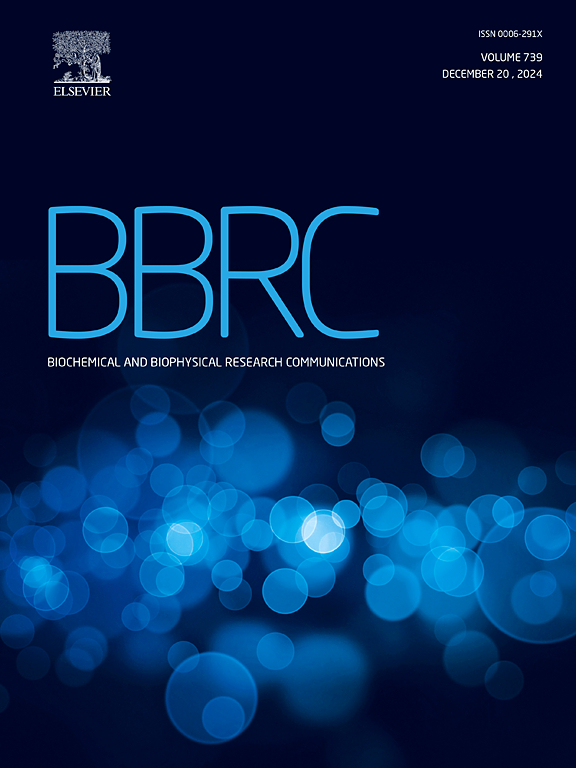RNA 结合蛋白 CUGBP2/ETR-3 调节 STAT3 的替代剪接。
IF 2.5
3区 生物学
Q3 BIOCHEMISTRY & MOLECULAR BIOLOGY
Biochemical and biophysical research communications
Pub Date : 2024-11-14
DOI:10.1016/j.bbrc.2024.151000
引用次数: 0
摘要
信号转导和转录激活因子 3(STAT3)是一种多因素调节器,参与多种生物反应。STAT3 前核糖核酸的替代剪接会导致外显子 23 内部 50 个核苷酸的缺失,选择一个替代的 3' 接受位点,从而产生两种剪接异构体,即 STAT3α 和 STAT3β。STAT3β 的 C 端缺少 55 个氨基酸残基的转录激活结构域,而 STAT3α 的 C 端则取代了 7 个独特的氨基酸。虽然 STAT3β 最初被认为是 STAT3α 的显性阴性异构体,但越来越多的证据表明,STAT3β 在基本细胞过程中既有其独特的功能,也有与 STAT3α 重叠的功能。然而,关于 STAT3 前核糖核酸替代剪接决定 STAT3 异构体之间的平衡,仍有许多未知之处。在这项研究中,我们确定了顺式调节元件和 CUGBP2/ETR-3 作为调节 STAT3 替代剪接的新型反式作用因子。我们的研究结果表明,STAT3 的剪接可通过 CUGBP2 与内含子 22 中富含 UG 的元件相关联而受到 CUGBP2 的调控,从而为 STAT3 替代剪接的机制提供了新的见解。CUGBP2 将是调节 STAT3 同工酶表达平衡的关键分子,因此靶向 CUGBP2 及其在 STAT3 内含子 22 中的识别序列可能会对 STAT3 信号通路调控的各种生物过程产生影响。本文章由计算机程序翻译,如有差异,请以英文原文为准。
RNA binding protein CUGBP2/ETR-3 regulates STAT3 alternative splicing
Signal transducer and activator of transcription 3 (STAT3) is a multifactorial regulator involved in many biological responses. Alternative splicing of STAT3 pre-mRNA leads to an internal 50-nucleotide deletion of exon 23 selecting an alternative 3’ acceptor site, resulting in the generation of two splicing isoforms, STAT3α and STAT3β. STAT3β lacks 55 amino acid-residue transactivation domain at the C-terminal of STAT3α replacing seven unique amino acids. Although STAT3β was originally thought to be a dominant negative isoform of STAT3α, accumulating evidence have shown that STAT3β possesses both its unique functions and those that overlap with STAT3α in fundamental cellular processes. However, much remains unknown about STAT3 pre-mRNA alternative splicing in determining the balance between STAT3 isoforms. In this study, we identified cis-regulatory elements and CUGBP2/ETR-3 as a novel trans-acting factor that regulates STAT3 alternative splicing. Our findings demonstrate that STAT3 splicing can be modulated by CUGBP2 via association with UG-rich elements of intron 22, providing a novel insight into the mechanism of STAT3 alternative splicing. CUGBP2 would be a crucial molecule regulating the balance of STAT3 isoform expression, thus targeting CUGBP2 and its recognition sequences in intron 22 of STAT3 might impact on various biological processes regulated by STAT3 signaling pathway.
求助全文
通过发布文献求助,成功后即可免费获取论文全文。
去求助
来源期刊
CiteScore
6.10
自引率
0.00%
发文量
1400
审稿时长
14 days
期刊介绍:
Biochemical and Biophysical Research Communications is the premier international journal devoted to the very rapid dissemination of timely and significant experimental results in diverse fields of biological research. The development of the "Breakthroughs and Views" section brings the minireview format to the journal, and issues often contain collections of special interest manuscripts. BBRC is published weekly (52 issues/year).Research Areas now include: Biochemistry; biophysics; cell biology; developmental biology; immunology
; molecular biology; neurobiology; plant biology and proteomics

 求助内容:
求助内容: 应助结果提醒方式:
应助结果提醒方式:


